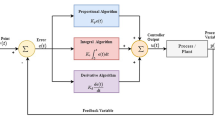Abstract
This paper utilizes the improved particle swarm optimization (IPSO) technique for adjusting the gains of PID controller, iterative learning control (ILC) and the bandwidth of Butterworth filter of the ILC. The conventional ILC learning process has the potential to excite rich frequency contents and to learn the error signals. However the learnable and unlearnable error signals should be separated for b ettering control process along with the repetitions. Since producing a high frequency error condition should be avoided before the phase margin cause any trouble. Learnable error signals through a bandwidth tuning mechanism should be adaptively injected into learning control laws and thus reduce the tracking error effectively at every repetition. The filter bandwidth should be changed at every repetition for the shape of compensated errors at frequency response thinking. Thus adaptive bandwidth in the ILC controller with the aid of IPSO tuning is proposed here. Simulation results show the new controller can cancel the errors efficiently as the process is repeated. The correlation coefficient that validates the learnable compensated error signal for the trajectory is adaptively decomposed from previous error history via the bandwidth tuning mechanism in the next repetition. The learnable error signals of the intrinsic mode functions through the empirical mode decomposition correlate efficiently with reduced tracking error with further repetitions. Simulation results validate the effectiveness of the IPSO-ILC for precision motion control of a robot arm link performing high speed maneuvering or computer numerical control commanding axis positioning.







Similar content being viewed by others
References
Antonino-Daviu J, Jover Rodriguez P, Riera-Guasp M, Arkkio A, Roger-Folch J, Perez RB (2009) Transient detection of eccentricity-related components in induction motors through the Hilbert-Huang transform. Energy Convers Manag 50(7):1810–1820
Elci H, Longman RW, Phan MQ, Juang J-N, Ugoletti R (2002) Simple learning control made practical by zero-phase filtering: application to robotics. IEEE Transactions on Circuit and System I: Fundamental Theory and Applications, pp 753–767
El-Gammal AAA, Sharaf Adel MA (2009) Modified design of PID controller for DC motor drives using particle swarm optimization PSO. In: Proceedings of Power Engineering, Energy and Electrical Drives, Lisbon, Portugal, pp 420–424
Fang H, Chen L (2009) Application of an enhanced PSO algorithm to optimal tuning of PID gains. Proceedings of 2009 Chinese Control and Decision Conference, Guilin, China, pp 35–39
Gabor D (1946) Theory of communication. Joint information exchange. Environment 93(26):429–457
Huang YC, Li YH (2014) Experiments of iterative learning control system using particle swarm optimization by new bounded constraints on velocity and positioning. Eng Comput 31(2):250–266
Huang NE, Shen Z, Long SR, Wu MC, Shih HH, Zheng Q, Yen NC, Tung CC, Liu HH (1998) The empirical mode decomposition and the Hilbert spectrum for nonlinear and non-stationarytime series analysis. In: Proceedings of the Royal Society, Vol. 454, pp 903–995
Jang HS, Longman RW (1994) A new learning control law with monotonic decay of the tracking error norm. In: Proceedings of the 32nd Allerton conference on communication, control, and computing, Urbana, University of Illinois pp 314–323
Kennedy J, Eberhart R (1995) Particle swarm optimization. In: Proceedings of IEEE International Conference on Neural Networks. Perth, Australia, pp 1942–1948
Lee-Glauser GJ, Juang J-N, Longman RW (1996) Comparison and combination of learning controllers: Computational enhancement and experiments. AIAA J Guid, Control Dyn 19(5):1116–1123
Middleton RH, Goodwin GC, Longman RW (1989) A method for improving the dynamic accuracy of a robot performing a repetitive task. Int J Robotic Res 8(5):67–74
Solihin MI, Akmeliawati W, Akmeliawati R (2009) Self-Erecting inverted pendulum employing PSO for stabilizing and tracking controller. In: Proceedings of International Colloquium on Signal Processing and Its Applications (CSPA), Kuala Lumpur, Malaysia, pp 63–68
Su YW, Chao JA, Huang YC (2014) Adaptive zero-phase filtering bandwidth of iterative learning control by particle swarm optimization. Lect Notes Electr Eng 293:1031–1037
Tsai MS, Yen CL, Yau HT (2013) Integration of an empirical Mode decomposition algorithm with iterative learning control for high-precision machining. IEEE/ASME Transaction on Mechatronic, 18(3):878–886
Wang D, Ye Y(2005) Design and experiments of anticipatory learning control: frequency domain approach. IEEE/ASME Transactions on Mechatronics. 10(3):305–313
Ye Y, Tayebi A, Liu X (2009) All-pass filtering in iterative learning control. Automatica 45(1):257–264
Acknowledgments
This work is supported by NSC Grant 102-2221-E-018-008, which the authors appreciate very much.
Author information
Authors and Affiliations
Corresponding author
Rights and permissions
About this article
Cite this article
Huang, YC., Su, YW. & Chuo, PC. Iterative learning control bandwidth tuning using the particle swarm optimization technique for high precision motion. Microsyst Technol 23, 361–370 (2017). https://doi.org/10.1007/s00542-015-2649-6
Received:
Accepted:
Published:
Issue Date:
DOI: https://doi.org/10.1007/s00542-015-2649-6




